by California Casualty | Firefighters |
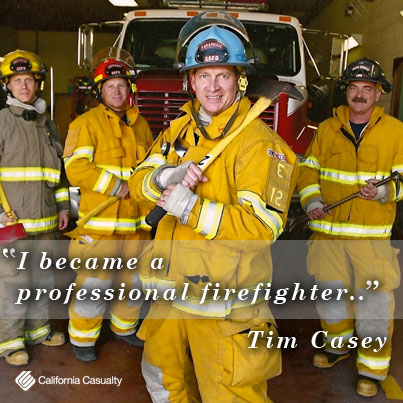
Tim Casey describes himself as, “a retired firefighter/paramedic, author, lecturer, public speaker and an alcoholic. As a public servant for more than 30 years, I know the hero business from the inside out, and I also know the costs of that profession; the human cost. My passion is trying to help save the lives of lifesavers. Firefighters are dying in record numbers, not on the job but by their own hands. Clinicians and therapists, although well intentioned, do not know how to help emergency workers and I want to help them understand us, and maybe save some lives along the way.
I became a professional firefighter/paramedic at 19 years of age and proceeded to work in that field for the next 31 years. Best job I ever had, the worst job I ever had, and it spanned four decades from 1979 until I retired in 2009. I delivered nine babies over those years, helped save hundreds of lives, and fought enough fire to keep me content into my golden years.
I became a firefighter quite by accident. Right out of high school, I went to work at the largest car dealership in my hometown. Things were going along well until the day I gave my unsolicited opinion to the general manager of the store. He admired the frankness of what I had to say but not the content of my statement.
Later that same day I called my father to tell him the news of my recent separation from work and to ask if he might be aware of any job openings. As in turned out he did know someone was hiring. The chief of a small fire department on the outskirts of town was looking for a firefighter. The next day I interviewed for the position and the day after that I was a fireman.
Looking back, I was too young, inexperienced, and naive to have made that decision; I had no idea of what was to come. I had stumbled into the coolest jobs any man could have. Overnight I went from being a zero to being a hero, an American icon, a firefighter.
I quite literally grew up in fire stations; I started as a teenager, I was married and divorced twice while I was a firefighter, I had three children, became an alcoholic, and survived a suicide attempt over those years. Throughout my entire adult life I was always part of a team and had tremendous resources available to me for all my decision-making – my fellow firefighters were more than willing to help me, especially the older guys who got a vicarious thrill out of hearing about my adventures.
The belief that we as firefighters are a brotherhood and sisterhood is deeply ingrained in our psyches from the outset of our career. No one outside our culture has any grasp on what it is to be a firefighter. People can imagine, but they can only guess how they might feel if they were confronted with the realities of our job.
However, their best guesses are based on film, TV, or literature; they are just that, a guess. If you have never walked in our boots, never walked through fire, death, and disaster, then you will never get it, you will never understand how we feel about each other.
That culture is one of the biggest problems facing the fire service, the notion that being a firefighter prevents us from being normal feeling people, from having emotions, from the damage our experiences, burden us with. It has to be abandoned, or we will suffer more and more tragedies like a result of “pulling on our big boy pants.”
We must learn to care for our own with the same vigor we extend to our customers. We must protect our people from these horrors, care for each other and our families, or we will attend more funerals and us will suffer the loss of great people because of pride, toughness, and bravado. I share my personal story of alcoholism and suicide so that when another firefighter is suffering and feeling they are alone in their struggle, they know they are not alone – that at least one other firefighter has stood in their shoes and made it out of the darkness. It’s me; I have, and I am willing to help in anyway I can.
Below are links to some valuable resources for a starting point.
4-steps-to-help-a-mentally-distressed-firefighter
Firefighter Behavioral Health Alliance
Initiative 13
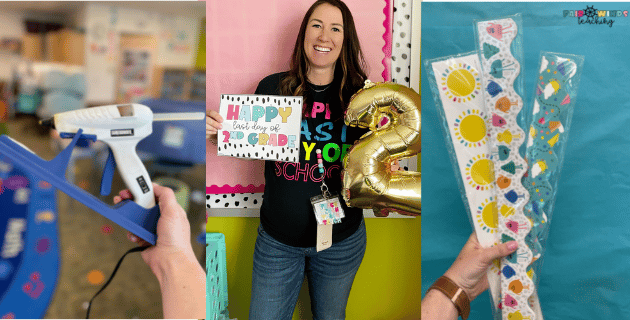
by California Casualty | Educators |
Written by Casey Jeffers, Owner of Fair Winds Teaching & MSEA Second Grade Teacher Packing up your classroom at the end of the year can be exciting and also challenging at the same time. However, I promise you… if you spend some time setting yourself up for...
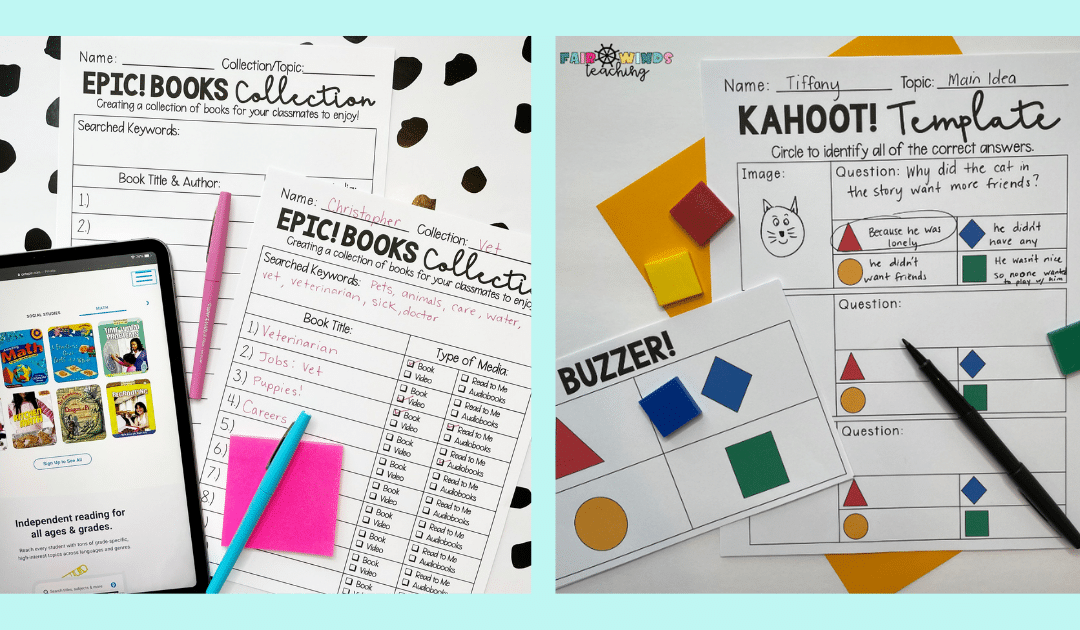
by California Casualty | Educators |
Written by Casey Keyser, MSEA Third Grade Teacher
Let’s chat about technology! Integrating technology into the classroom is my passion. It is an amazing way to engage your students in the content and to complete activities you wouldn’t have the means to do otherwise.
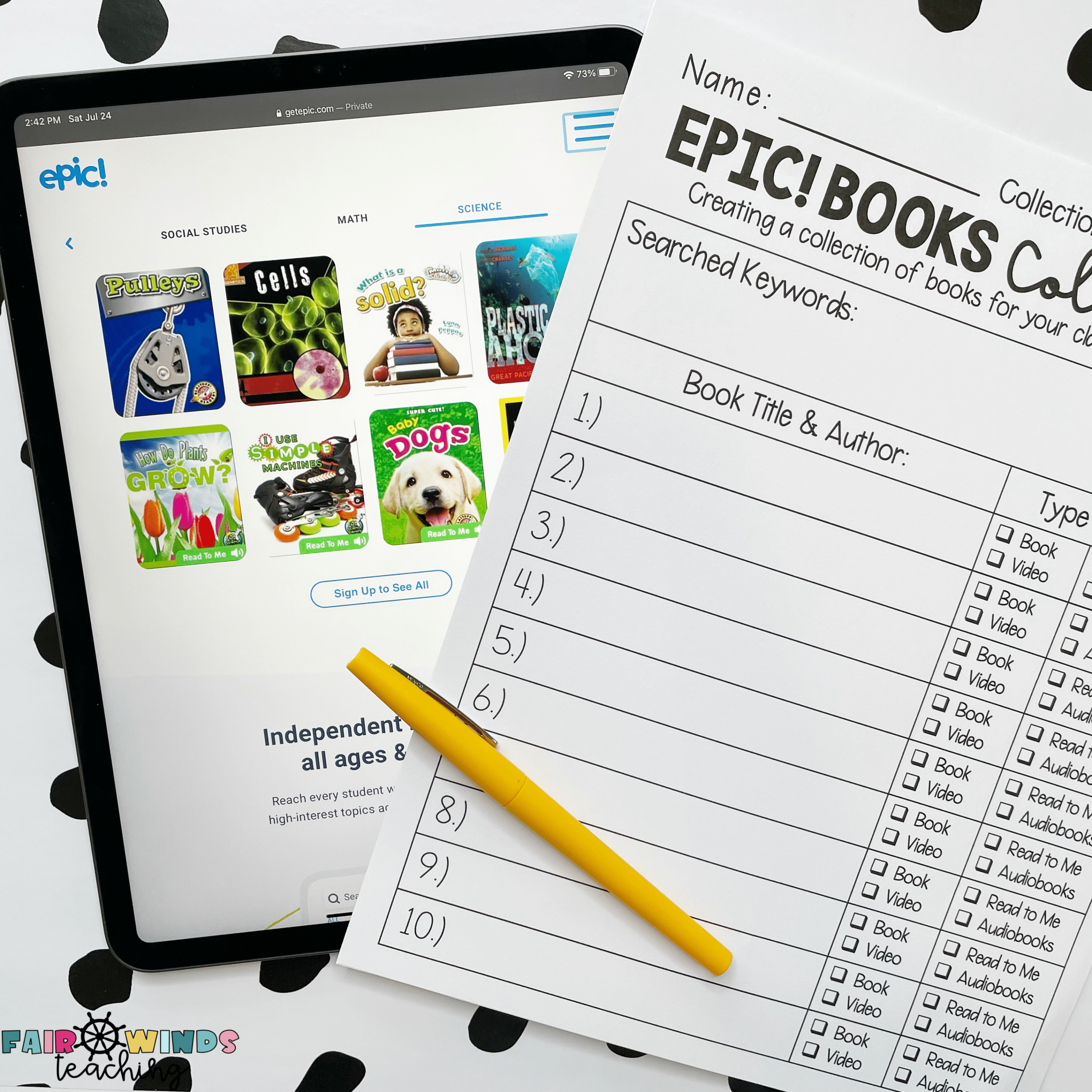
My first pro-tip about tech in the classroom is this… DO NOT use technology just for the sake of using technology.. I will also never advocate for technology to be used 24/7. Technology needs to be purposeful and planned to help build the lesson up, not be the center of the lesson. Well, unless you are teaching a lesson on how to use a search engine on the Internet (which by the way, needs to be explicitly taught.) If the lesson you are planning is better served with a paper/pencil, journal, or hands-on manipulatives… do that instead.
If you are not familiar with the SAMR model, please take a moment to check it out here.

Now let’s dive into some technology uses for classrooms. I have a few favorite categories I like to use technology for. These are not content or grade-level specific so they can be used for any topic. We’re going to chat about integrating music, video, reading, and assessments tech tools into your classroom. If you use these categories when you are planning lessons, chances are, you will fill your classroom with engagement and excitement.
First up… Music technology.
Let’s talk about the amazing website Flocabulary. This incredible company creates educational hip-hop songs, videos, and additional educational materials to use in the class. They have topics anywhere from Reading and Science to Social and Emotional Learning (SEL). You can find songs to teach topics in all grade levels Pre-K to 12. They are so fun and engaging to learn with your students in a whole group setting or assigned to them individually. You are able to have a FREE 45-day trial of Flocabulary the first time you sign up, it is totally worth the try!
If you, your school, or your district subscribes to Flocabulary, I highly encourage you to check out this Flocabulary Accountability playlist. This template is used when students complete a Flocabulary Playlist online. You can either print one for students to use or have a PDF option for Kami or Google Slides online. This allows students to have a paper/note-taking option to build their planning skills. As a teacher, it also makes grading their assignment a lot easier because I can see their work while they work through the lessons. Integrating music into any content is a great way to help students remember what they are learning and become creative enough to write their own lyrics.
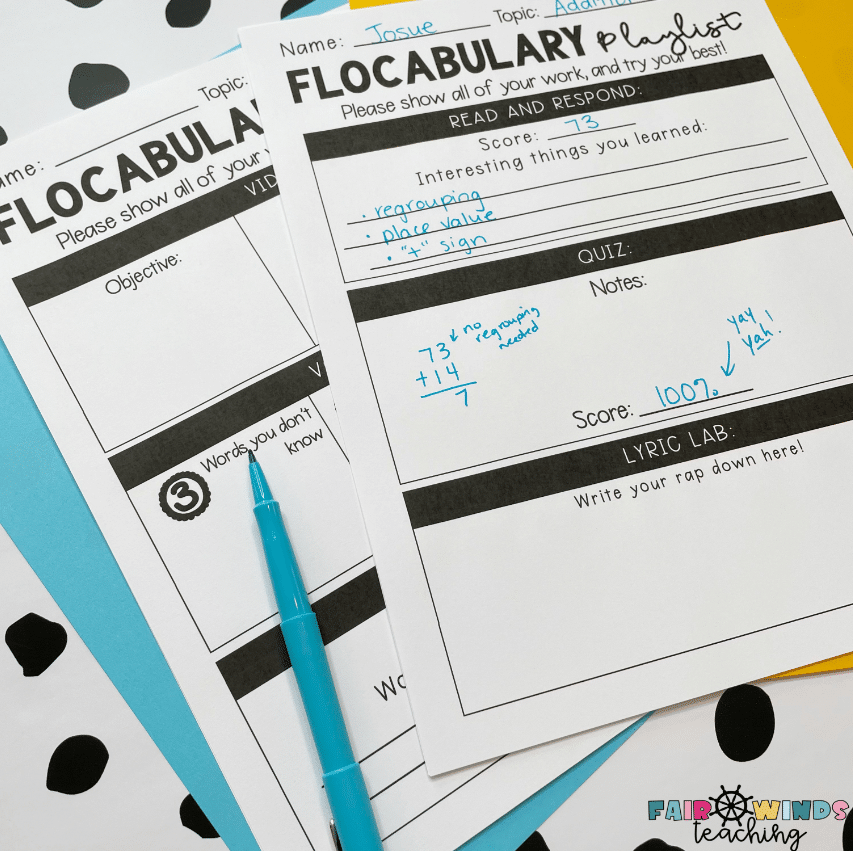
Next up… Video technology.
My student’s favorite tech tool is Flipgrid. This tool is a simple, free, and accessible video discussion experience for learners and families. You can start a discussion and engage students and their community with one click of a green plus sign. Your students get to add personalized touches by adding a selfie cover photo and stickers to help support the topic. To learn more about Flipgrid check out this super helpful Getting Started video.
I never let my students go live on Flipgrid unless they have planned out their script beforehand. I use these quick and easy templates to help them get organized and started. Grab these easy-to-print Flipgrid Video Templates here.
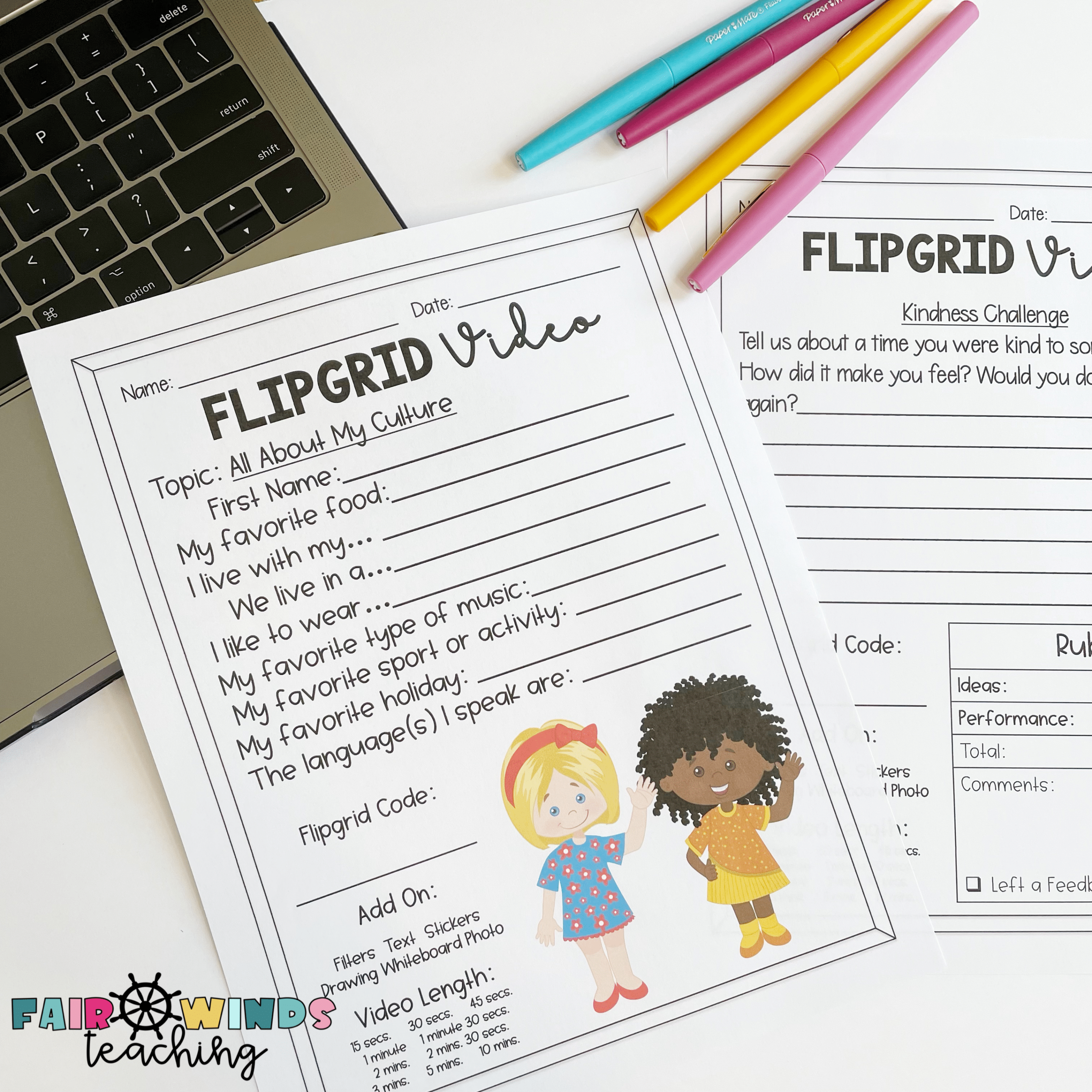
Another classroom pro tech tip, is to never let students use a new piece of technology for academic purposes first. They will not be engaged in learning the intended content or feel successful in learning how to use the new tech tool. Instead, ALWAYS onboard your students by having a fun intro activity to the tech tool/website. For example, have the students complete a building community activity such as Two Truths, One Lie using Flipgrid first. That way, they become familiar with the tool and not necessarily on the content at hand. This also allows the other students to watch their classmates’ videos and respond. All the practice is learning how to use the tech tool so that when it comes to your next lesson, they are ready!
Third in the queue… Reading!
When I want to add a reading component in my technology rotation, I look to the Book website to help provide my students with book collections curated for them on any topic. You can add books, audiobooks, video,s and read-aloud books to a collection and assign them to your students. I also want my students to be able to create their own collections of books. First, I have them create collections of hobbies and favorites to share with their classmates, and then I have them create book collections on topics we are currently researching. I use my Epic! books collection sheet to have them write down all the books they find on a topic.
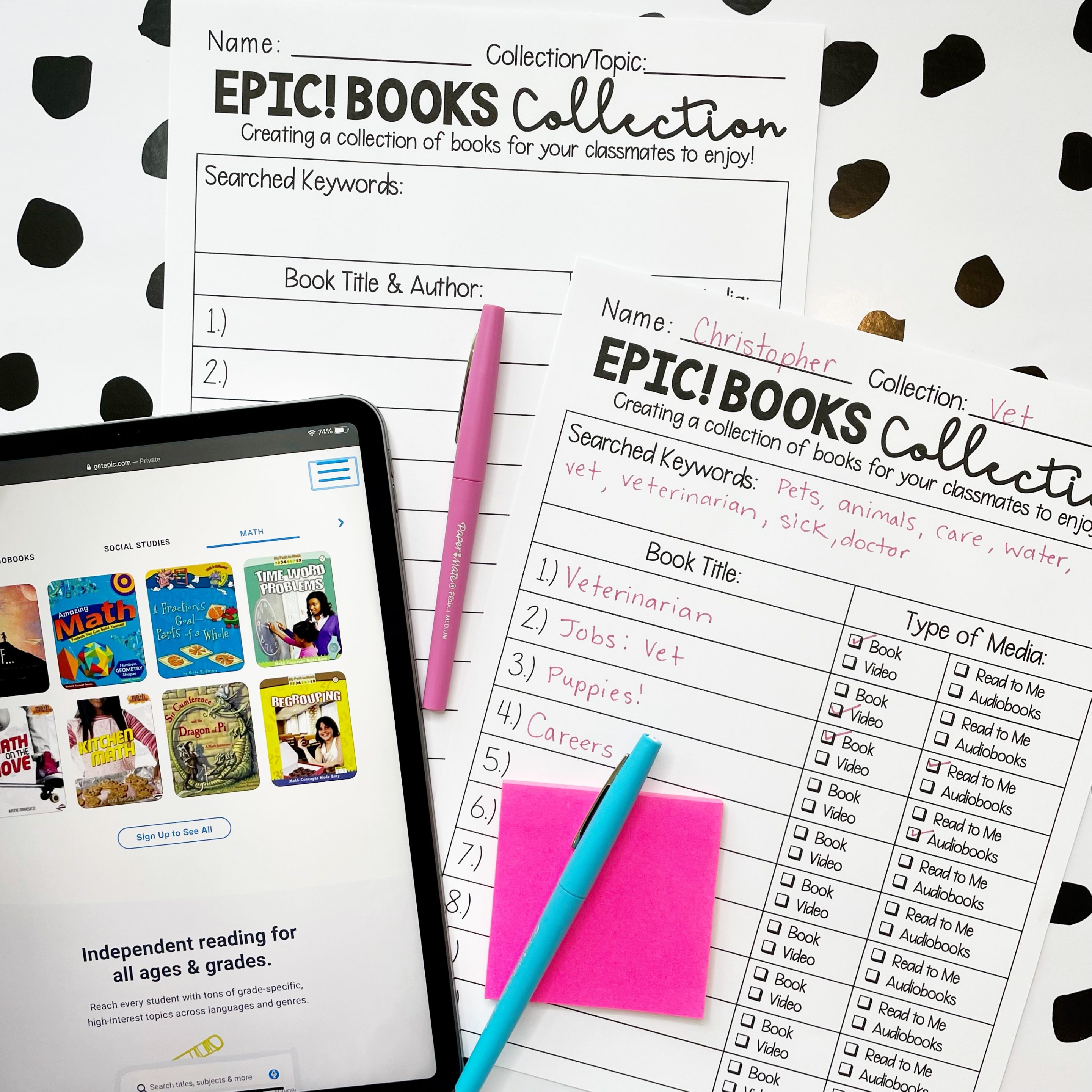
Using keywords and search tools are just a few essential skills students should learn about researching. Not to mention, Epic! books can help foster a love for reading and exposing them to all types of genres.
On to Assessments… yay!
There are so many amazing assessment tools out there, but I wanted to give examples of both high and low tech.
My new favorite tech tool is called Factile; this website has a free and paid version. As a teacher that NEVER pays for ANY tech tool, I love being able to have up to 5 teams for free. Here is a little trick to have your entire class be able to all play at the same time.
Split your class into 5 groups and assign a team leader to be the reporter of answers. Give every student a piece of blank paper and an invisible ink pen. I get the ones that have the black light on the top of the cap and I buy online in bulk and they last forever. Then the entire class writes down their answers to the assessment questions as we go and only the reporter turns in the answer. This way students can’t see each other’s answers and won’t be embarrassed to try each question. Pro tech in the classroom tip, you can use this trick with most of the online assessment tools.

Last but not least… a classic,
I know that most teachers have already heard of Kahoot!, however, I have been able to add a little spin on it. I am always looking for ways to give my students more control over their own learning, so why not have them create the Kahoot!?.
I have my students use this template (paper and digital option) to write their own Kahoot! Assessment questions for any topic. They have used this template for Science, two-step word problems, main idea comprehension questions, phonics and so much more. The sky is the limit with what they can create.
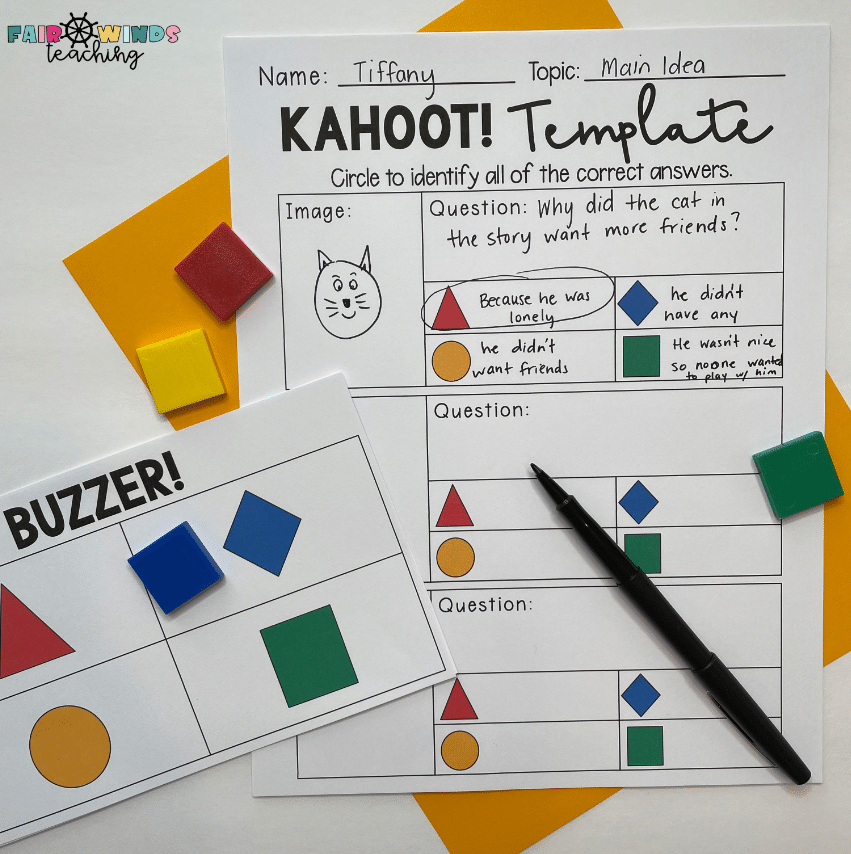
I also use my low-tech printable Kahoot! buzzers to allow the class to play on days we don’t have access to our devices. You can start an online assessment as a whole class on one teacher projector and have them tap their fingers on their decks to answer each question. I walk around the room with a clipboard to tally up an idea of the student’s understanding. You can find that Kahoot! Template and buzzer here!
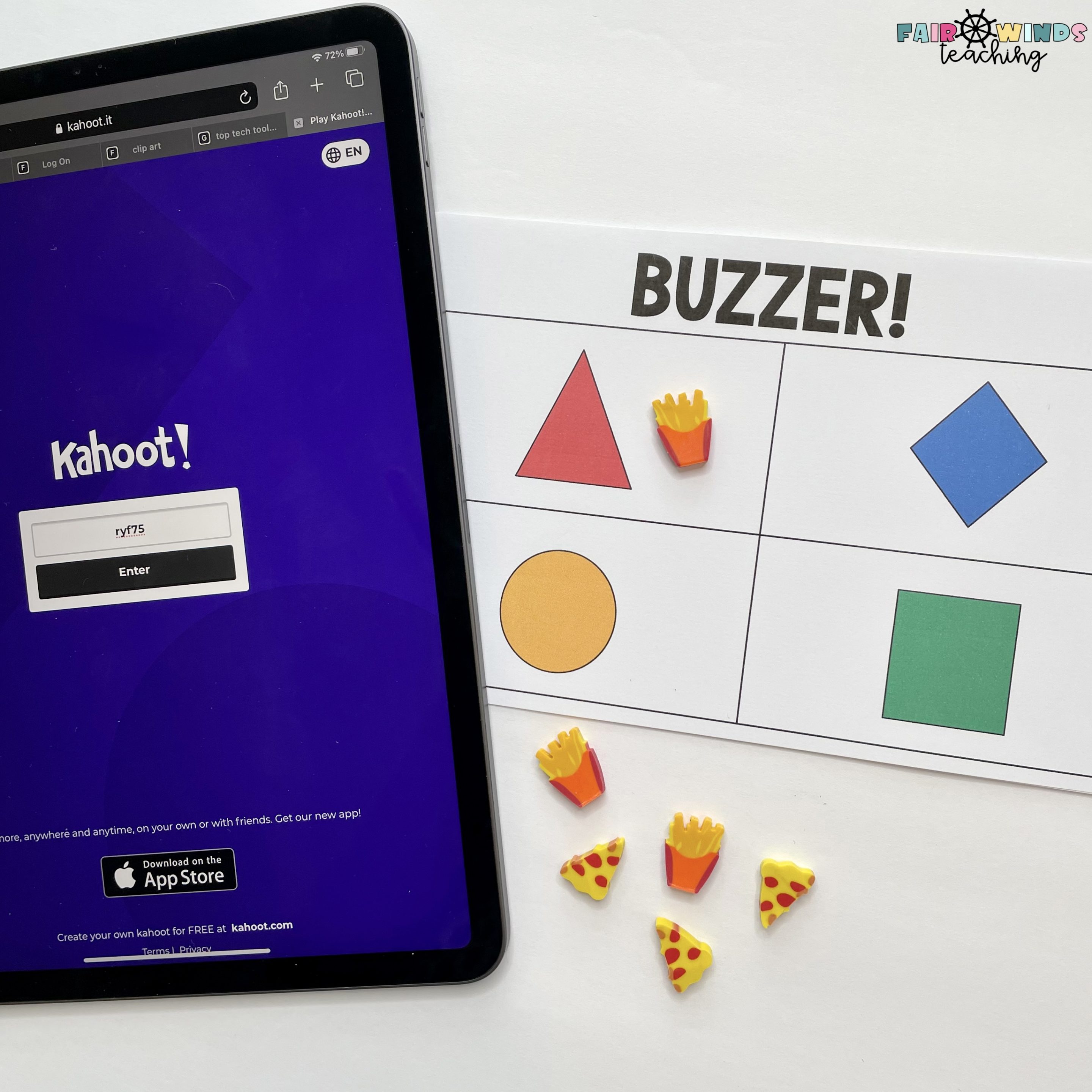
Don’t let barriers, like thinking ‘I’m not a “techy” person’ or ‘my school doesn’t have the technology available’, block you from trying a new tech tool in your classroom. I challenge you to try one new tech tool the first month of school. Let your students (and yourself) explore the tech tool first in a fun way, then dive right in with your content. You got this!

Casey Keyser is a third-grade teacher at Butterfly Ridge Elementary in Frederick County, Maryland. She was recently recognized as the national winner of the NEA Foundation’s 2021 Teaching in Excellence Award. Casey is the proud owner of the Education Resource Blog, Fair Winds Teaching, and loves to connect with her education community through her TeacherPayTeacher’s business.
by California Casualty | Educators |
Written by Casey Keyser, MSEA Third Grade Teacher
 Teachers are like solar panels, we recharge in the Summer. However, this shouldn’t be the only time we recharge. We should have an ongoing plan to help energize ourselves daily and when done so correctly, rarely need a recharge at all.
Teachers are like solar panels, we recharge in the Summer. However, this shouldn’t be the only time we recharge. We should have an ongoing plan to help energize ourselves daily and when done so correctly, rarely need a recharge at all.
Let’s talk about teacher burnout…
Are you missing happy hours or Sunday brunch with friends most weekends? Are you declining family time or weekend trips because you, “had” to lesson plan or, “needed to” to get your grading done?
Did you volunteer for that committee or club because you thought it would look bad if you didn’t?
Are you spending your duty-free lunch breaks completing paperwork, working with students, or emailing parents?
Have you arrived at school 2 hours before students arrive to be prepared for your day?
For me… it’s an overwhelming YES, YES, YES ….. & YES.
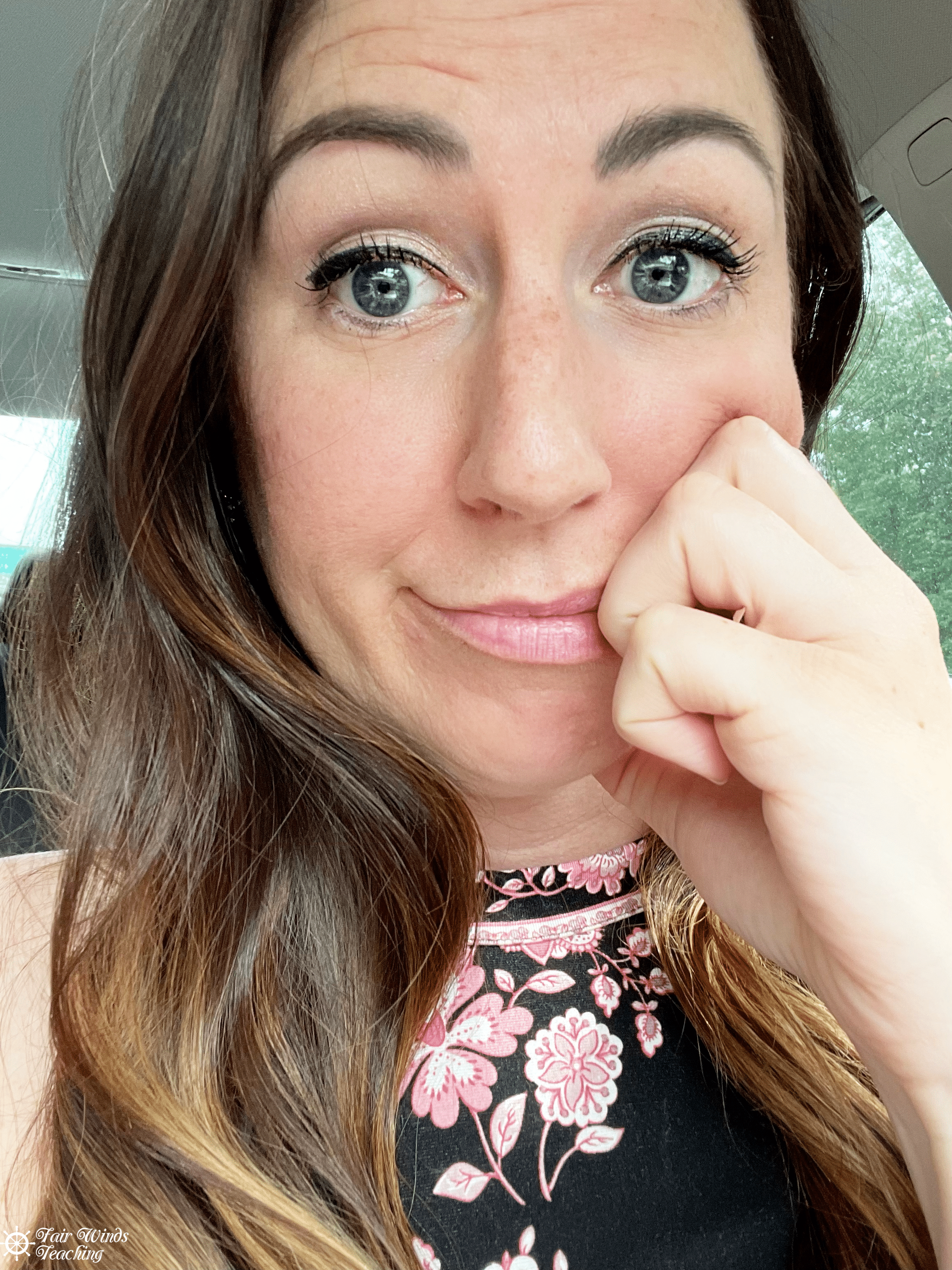
Each and every day, teachers GIVE so much to our students. Of course we want to do anything and everything for our students all the time. But is it healthy or sustainable over time?
NO, you will burn yourself out!
Teacher burnout is a very common problem that needs to be talked about more. I believe it is hard to identify if it’s happening to you because, “You can’t read the label, when you’re stuck inside the bottle.” For some teachers, it’s hard to understand and accept when it’s time to start saying, “No,” and take a break.
These difficult conversations need to happen. We have to start working together to normalize teachers saying, “No.”
Saying “No” isn’t always a bad thing. It can even be what’s in the best interest of your students.
Over my 11-year teaching career I have heard a lot of talk about having a good or healthy work-life balance. I have been given tips and tricks to maintain self-care and a happy life. But what no one ever talks about is that it’s not a “One size fits all” approach.
I do not believe in, “work-life balance.” I don’t think there is a magical formula of how each teacher can “balance” their work and their home life at the same time. I think that it should be called, “work-life fit.” A work-life fit is the flexibility to make choices for your own life that fits into what you have going on in that moment. You should be able to create a work environment and lifestyle that fosters both personal and professional life at the same time. As educators, we cannot compare ourselves to each other. What “fits” in one teachers’ life, might not “fit” into yours.
Your goal is to do only the extra things if it fits into your life at that moment. If it doesn’t, don’t do them. And if you are in a place to do extra things you want to for your classroom, do it. Don’t let anyone else shame you for going above and beyond in your career if that’s what fits in your life.
But if you are a teacher that doesn’t have the space and time for all the “extra” things, and you are still trying to squeeze them in, this is when you will experience teacher burnout.
Dr. Leah Katz @dr.leahkatz shared a graphic on signs of burnout. It is important to know what to look for, for yourself, your colleagues, and family members that are educators.
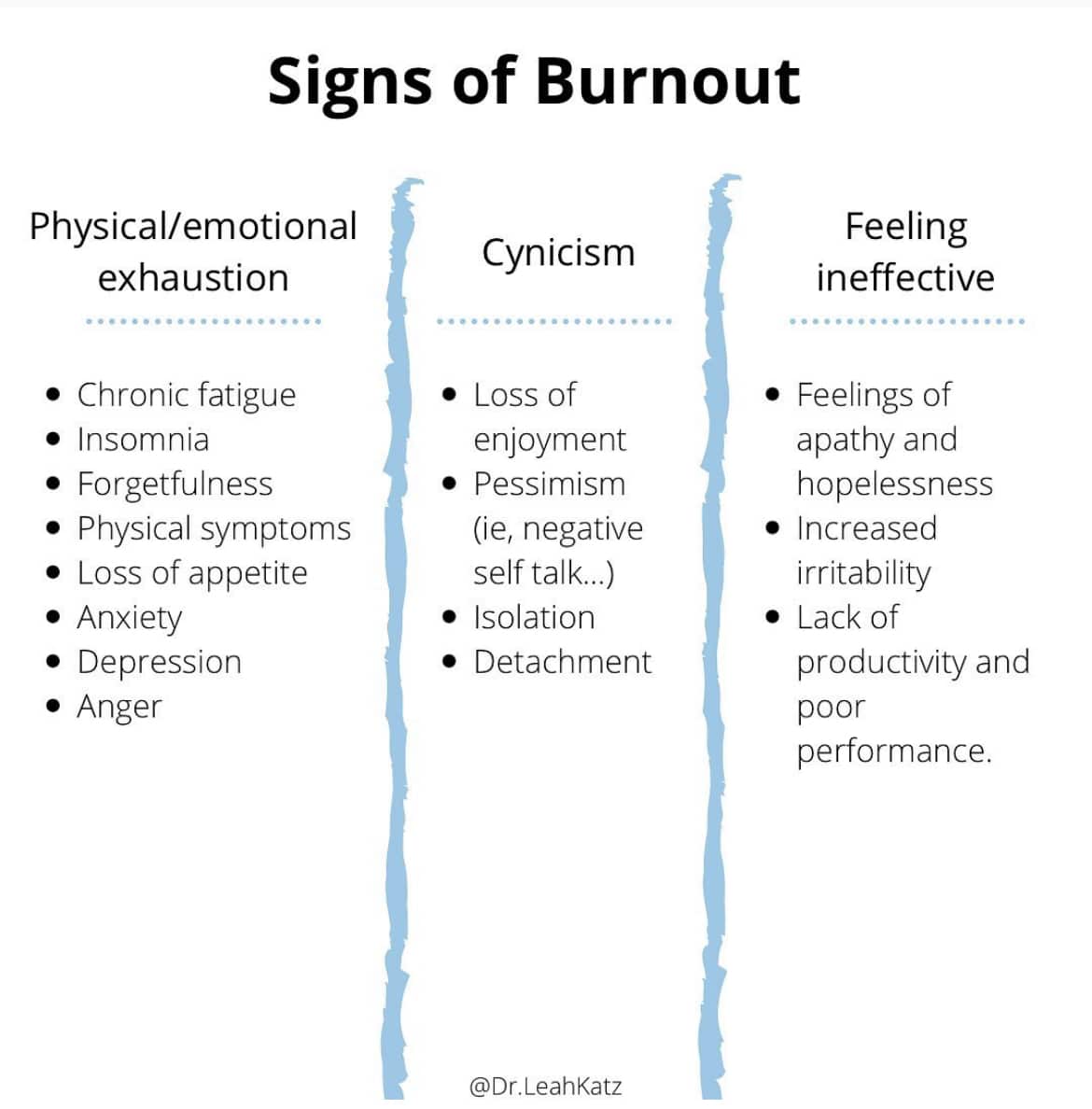
When I start to feel or see signs of burn-out I focus on two things – my mindset and setting boundaries. I have to keep my mindset focused that things will get better. Then I have to act to make that a reality.
I sit down to create a list of things I can take off my plate and specific goals on how I can set boundaries for new things that may come my way. Here is a list of the boundaries I have set for myself.
Don’t:
-
- Spend all evening/weekend working… I work on the weekends, but I don’t let it steal my entire time
- Skip breakfast… I love to meal prep on Sunday so that this doesn’t happen
- Drink only coffee… I am the worst at hydration so I make sure to always have a water bottle
- Stay past your contact hours… unless I am getting paid and I WANT to
- Check your email after 4 PM… just don’t do it, it can wait.
- Feel guilty about setting boundaries and saying, “No.”
- Lie awake thinking about school
However, I can choose to do some of these things once in a while, IF I think they fit into my life AND I know they bring me joy.
As we move into the new school year, I am already trying to find where I can pause for some peace. Where can I build time into my schedule to reflect and do tasks that calm me? I reflect on what energizes me and how I can surround my life with those things and people.
Give yourself grace. Give yourself time. Give yourself an honest talk about what “fits” with your life.
If you start to experience teacher burnout and you are aware of how to find your peace and calm, you will be able to better read the label on your bottle because you won’t be stuck inside anymore.

Casey Keyser is a third-grade teacher at Butterfly Ridge Elementary in Frederick County, Maryland. She was recently recognized as the national winner of the NEA Foundation’s 2021 Teaching in Excellence Award. Casey is the proud owner of the Education Resource Blog, Fair Winds Teaching, and loves to connect with her education community through her TeacherPayTeacher’s business.
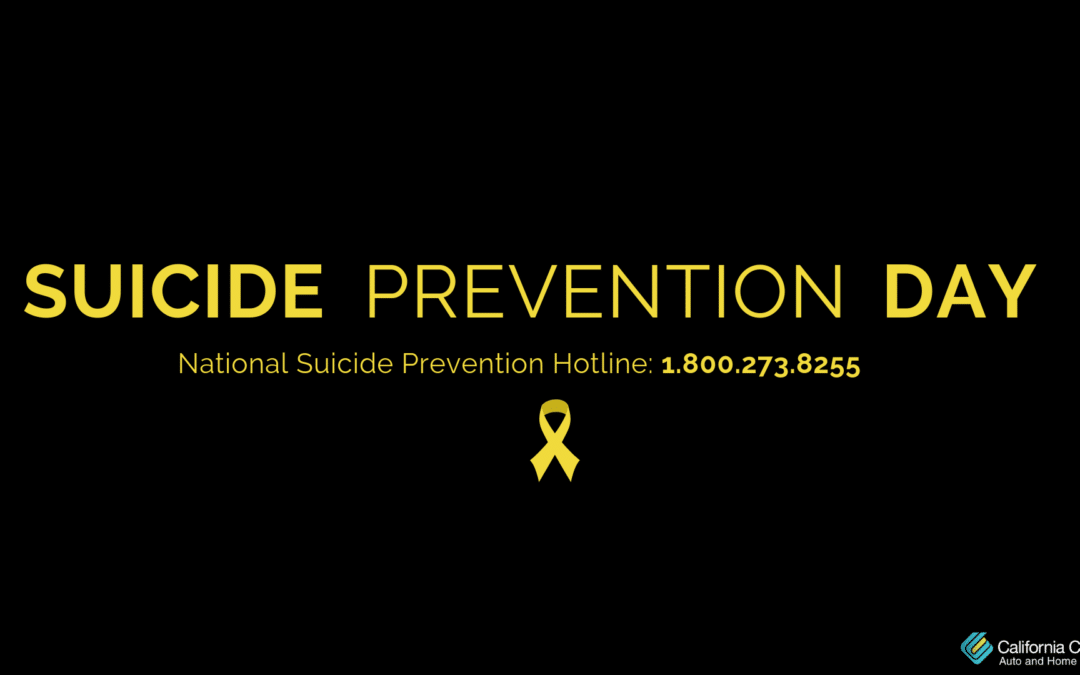
by California Casualty | Auto Insurance Info |
By Mark Goldberg, Communications Specialist with California Casualty
September 10th is World Suicide Prevention Day, and many people don’t like to talk about it, but it’s time to start.
The topic of suicide got a lot more personal for me four years ago when a good friend and retired firefighter, Tim Casey, took his life. Tim had written for the California Casualty blog about his life as a firefighter and the scars (both physical and mental) he carried from his 30 years as a first responder. His moving articles about mental health and PTSD in the fire service are real eye-openers.

I knew Tim had his struggles; he admitted that he was a recovering alcoholic, haunted by the things he saw on the job. He battled PTSD and the desire to drown those images in a bottle of booze, but on the outside, it appeared things were looking up for Tim. He was engaged to a wonderful woman, was very involved in spreading awareness about first responder suicides, and was teaching at one of the local universities. The last time I talked with Tim he seemed upbeat and happy, but I guess the demons were stronger than I or many others knew.
The Growing Problem of First Responder Suicide
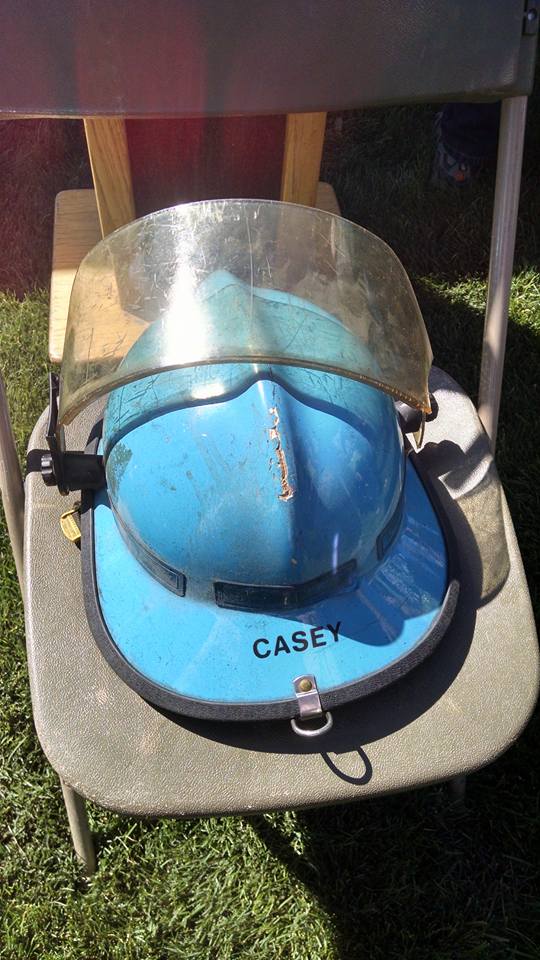 His funeral was moving, but it left me feeling sad and empty. I came away determined to do what I could to help carry on Tim’s mission to alert others about the growing epidemic of firefighter and first responder suicide. It’s a daunting task; the number of law enforcement and firefighter suicide deaths has now surpassed those who die in the line of duty.
His funeral was moving, but it left me feeling sad and empty. I came away determined to do what I could to help carry on Tim’s mission to alert others about the growing epidemic of firefighter and first responder suicide. It’s a daunting task; the number of law enforcement and firefighter suicide deaths has now surpassed those who die in the line of duty.
And that’s a problem; firefighter ranked second in CareerCast’s annual survey of the most stressful jobs for 2019, right after soldiers. Being a police officer ranked fourth on the list.
Both jobs are dangerous, with constant life-threatening situations and unspeakable tragedies. One can only imagine how the searing image of injury and trauma can impact a person.
The daily stress, combined with limited opportunities to talk about it, is taking a toll. 243 first responders committed suicide in 2018- and that number is only predicted to rise through 2019, with many others suffering PTSD. It’s a problem these professions can’t afford to ignore.
Help for First Responders
Suicide was a little-discussed topic by fire departments until Captain Jeff Dill created the Firefighter Behavioral Health Alliance (FBHA). Dill started the nonprofit after hearing about the emotional impact the World Trade Towers disaster had on firefighters in 2001 and talking with first responders about lack of mental health resources for those returning from the devastation of Hurricane Katrina in New Orleans. Captain Dill thinks the number of firefighter suicides that get reported is only the tip of the iceberg. He formally began the nonprofit in 2011 to directly educate firefighters/EMS personnel and their families about behavioral health issues, such as depression, PTSD, anxiety, and addictions – as well as firefighter suicides.
We recently had a chance to talk with Chief Dill about the FBHA and the mission of suicide prevention among the men and women who protect us. Dill also knew Tim Casey.
Tell us a little bit about yourself and FBHA.
I am a recently retired fire officer with over twenty-five years in the fire service, Master’s Degree in Counseling and founder of Firefighter Behavioral Health Alliance (FBHA). I can tell you from experience that looking into ourselves is very difficult.
FBHA is the only known organization that tracks and validates firefighter & EMT suicides in the U.S. We never use names or organizations unless families give us permission. We do take the known information and present workshops across N. America to educate our brothers and sisters.
How does FBHA reach out to Fire/EMS?
We help fire/ems departments learn how to recognize when a coworker is struggling and how to reach out to that person. We had two themes for our workshops until recently. The two were “Challenge With Compassion” and “Be Direct”. The premise was if you see someone struggling, acting different or hear things from them, then you need to Challenge with Compassion and Be Direct in your approach.
We know that people actually see us better than we see ourselves, so listen to them when they tell you “you’ve changed.” I have added the term that so many people have now heard this past year in our workshops, and that is we must do – an “Internal Size-Up”.
This simply means, what is going on in your life? Could these issues become monumental to the point that we become depressed, anxious, create suicidal ideations or become addicted to some type of vice? At times, we subconsciously begin to act in ways that only others can see. So when someone says to you “what is going on with you?” please do not take offense, take a look at your life!
Why is it so hard for first responders to ask for help?
In every workshop we deliver we talk about Traditional Brainwashing. This quite simply means we become a product of our training, experiences and historical beliefs. From our first days in either fire or EMS academies, we are taught everything to become confident and competent firefighters and EMT’s, yet, the greatest error is the lack of behavioral health.
The instructing of horrific things you will see and how they might play out in your life for a lifetime. The stress, anxiety, depression, sleep deprivation, PTSD and relationships that might go south leading to a high rate of divorce are all real issues we face yet never taught because it is a negative for our traditions! We are afraid to talk about it because we are taught not to.
When things are going rough for you then the greatest thing you can do for yourself is to listen. When people, who see us from a different point of view than ourselves, notice that something is different, then maybe it is time to look at our lives by performing an Internal Size-Up. This means seek professional help, talk to a chaplain, peer support or just a friend.
We, in the fire and EMS service, must remember we are human beings first. We are performing to standards that the general public will never understand. We are seeing things the general public will never see. So listen to others because maybe they are seeing things in us we will never see!
Stay safe!
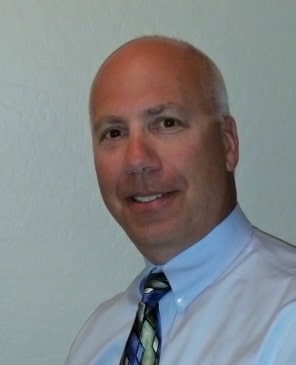
Jeff Dill, Founder of Firefighter Behavioral Health Alliance – NPO (FBHA)
Thank you, Chief Dill, for your time.
Resources for First Responders in Crisis
So, what can we do? First, take the time to ask questions and offer help to a first responder who appears to be stressed, depressed or hurting. In one of his articles for California Casualty, Tim said if someone had really taken the time to press him, to ask him what he was feeling, he probably would have cracked and exposed his hurt. The sad truth is, maybe Tim or a first responder you know, was one conversation away from still being here with us.
More and more resources are being created to help first responders deal with and talk about the stresses of their jobs. The Firefighter Behavioral Health Alliance is a great first step, with information and links to support agencies. Other groups are now offering help for first responders in crisis:
- Safe Call Now – providing a confidential, comprehensive 24-hour crisis referral service for public safety members, 206-459-3020, safecallnow.org
- HelplineEmergency Ministries – providing chaplains for first-responder counseling and support, emergencychaplain.org
- Rosecrance Florian Program – offering substance abuse treatment and PTSD support for uniformed personnel, https://rosecrance.org/addiction-treatment/florian-program/
- NVFC Fire/EMS Helpline, 1-888-731-FIRE
- American Academy of Experts in Trauma Stress – collaborating with organizations to meet the needs of victims and survivors, aaets.org
- The Code Green Campaign – advocating for mental health awareness and education for first responders on how to provide care for themselves and their peers and reduce the stigma preventing people from admitting they have a problem and not seeking help, https://codegreencampaign.org
- Blue H.E.L.P – dedicated to reducing mental health stigma through education, advocate for benefits for those suffering from post-traumatic stress, acknowledge the service and sacrifice of law enforcement officers lost to suicide, assist officers in their search for healing, and bring awareness to suicide and mental health issues, https://bluehelp.org/
The goals of organizations like these is to raise awareness of the problem, end the stigma, and to find support for every firefighter and first-responder in need. But, if we don’t talk about the problem, we can’t solve it.
If you know a first responder, maybe someone you love, start the discussion. Ask them what they are feeling, how they are dealing with the stress of the job, and offer help. If you’re thinking there’s not a good time to bring up the subject, remember that this is also Suicide Prevention and Awareness Month. Too many good men and women, our protectors, are ending up as statistics in the battle against suicide.
If you or someone you love is having depressed or suicidal thoughts call the National Suicide Prevention Hotline at 1.800.273.8255.













 Teachers are like solar panels, we recharge in the Summer. However, this shouldn’t be the only time we recharge. We should have an ongoing plan to help energize ourselves daily and when done so correctly, rarely need a recharge at all.
Teachers are like solar panels, we recharge in the Summer. However, this shouldn’t be the only time we recharge. We should have an ongoing plan to help energize ourselves daily and when done so correctly, rarely need a recharge at all. 



 His funeral was moving, but it left me feeling sad and empty. I came away determined to do what I could to help carry on Tim’s mission to alert others about the growing epidemic of firefighter and first responder suicide. It’s a daunting task; the number of law enforcement and firefighter
His funeral was moving, but it left me feeling sad and empty. I came away determined to do what I could to help carry on Tim’s mission to alert others about the growing epidemic of firefighter and first responder suicide. It’s a daunting task; the number of law enforcement and firefighter 